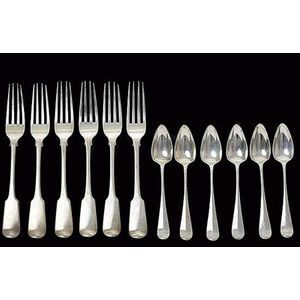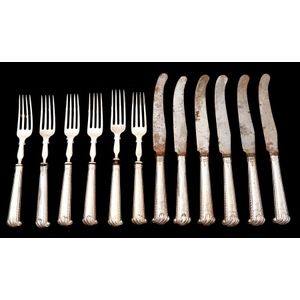George III Scroll Pistol Grip Flatware Set, Sheffield 1774
You must be a subscriber, and be logged in to view price and dealer details.
Subscribe Now to view actual auction price for this item
When you subscribe, you have the option of setting the currency in which to display prices to $Au, $US, $NZ or Stg.
- George Iii - George III (1738 - 1820) was King of Great Britain and Ireland from 1760 to 1820.
- Pistol Grip - Usually found on knives, and in use from about 1730, the pistol grip handle tapers out from the blade toward the end of the implement, and then curls in the shape of the truncated handle of an early pistol.
The grip is seen occasionally on forks, and also used to describe the handles on an urn where the handle rises up from the body of the urn towards the top, but turns down before meeting the neck, leaving a gap between the neck and the handle - Flatware - An alternative name for items of cutlery, principally knives, forks and spoons, now generally used to describe sets of these implements. Nowadays it is mostly used when describing cutlery made of silver and silver plate.
It is less frequently used to describe all "flat' items of tableware, so that as well as cutlery the definition includes plates. - Date Letter on Silver - A date letter is a letter or symbol that is used to mark silver and other precious metals to indicate the year in which the piece was made. The date letter system is used by the British hallmarking system and it is a way to verify that a piece of silver is genuine and has been assayed (tested) by an official assay office.
The date letter system has been in use since the 14th century and it changes every year, so it is possible to identify the year in which a piece of silver was made by looking at the date letter. The date letter is usually stamped alongside other hallmarks such as the maker's mark, and the standard mark (indicating the fineness of the metal) on the silver piece. The style of the letters varies depending on the assay office, and the style of the lettering also changes over time. The date letter is usually placed inside a shield shape, sometimes accompanied by other symbols.
The date letter system is not used in all countries, so if a piece of silver does not have a date letter, it does not necessarily mean it is not authentic. The date letter system is not always used for small or insignificant silver items.
This item has been included into following indexes:
Visually similar items

A Danish 830 silver Carl M. Cohr 27pcs, Diana part flatware set, circa 1940's, comprising of 8 table knives (stainless blades), 8 dinner forks, 8 table spoons, 2 serving spoons, 1 ladle stamped with ' cmC' monogram, Carl M Cohr, Fredericia, Copenhagen and

A set of six George III provincial silver fiddleback forks by John Robertson II and John Walton, Newcastle 1816, of typical form, initialled F verso, 417 grams, together with a set of silver grapefruit spoons by Edward Viner, Sheffield 1930, weight 200 gra

An 'Empire' English sterling silver cutlery service by Robert and Beck, Sheffield late 20th century, comprising a full setting for twelve and accoutrements; 2 x large salad servers, 2 x small salad serving, 1 x serving spoon, 1 x large meat fork, 1 x small

Elkington & Co. Kings pattern silver cutlery set. Six each knives, forks, dessert spoons and teaspoons (in all 24 pieces) weight 1 kg. Approx.
